Growth and Survival of Endemic Cacti under Different Substrate Types and Sun Exposures for Their Optimal Establishment in Northeastern Mexico
Abstract
1. Introduction
2. Materials and Methods
2.1. Study Area
2.2. Biological Material
2.3. Acclimatization and Field Transfer of the Species Studied
2.4. Experimental Design
2.5. Statistical Analysis
3. Results
3.1. Survival
3.2. Diameter and Height of Cacti
3.3. Relationship of Growth Parameters with the Combinations Substrate/Sun Exposure
4. Discussion
4.1. Survival in the Field
4.2. Growth in Natural Habitat
5. Conclusions
Author Contributions
Funding
Acknowledgments
Conflicts of Interest
References
- Areces, A. Cactaceae. In Flowering Plants of the Neotropics; Smith, N., Mori, S.A., Henderson, A., Stevenson, D.W., Heald, S.V., Eds.; Princeton University Press: Princeton, NJ, USA, 2004; pp. 73–76. [Google Scholar]
- Durán, G.R.; Méndez, G.M.E. Cactáceas. In Biodiversidad y Desarrollo Humano en Yucatán; Durán, R., Méndez, M., Eds.; SEDUMA: Mérida, México, 2010; p. 496. [Google Scholar]
- Hernández, H.; Godínez, H. Contribución al conocimiento de las cactáceas mexicanas amenazadas. Act. Bot. Mex. 1994, 26, 33–52. [Google Scholar] [CrossRef]
- Sánchez, M.H. Some Prehispanic Uses of Cacti among the Indians of Mexico; Goberment [ie Government] of Mexico State, Secretaría de Desarrollo Agropecuario, Dirección de Recursos Naturales: México City, México, 1982.
- Alanís, G.; Velazco, C. Cactáceas de Nuevo León. Available online: https://www.naturalista.mx/guides/1424 (accessed on 02 June 2017).
- Godínez, A.H.; Valverde, T.; Ortega, B.P. Demographic trends in the Cactaceae. Bot. Rev. 2003, 69, 173–203. [Google Scholar] [CrossRef]
- Holland, J.N.; Molina, F.F. Hierarchical effects of rainfall, nurse plants, granivory and seed banks on cactus recruitment. J. Veg. Sci. 2013, 24, 1053–1061. [Google Scholar] [CrossRef]
- Mandujano, M.C.; Montaña, C.; Méndez, I.; Golubov, J. The relative contributions of sexual reproduction and propagation in Opuntia rastrera from two habitats in the Chihuahuan Desert. J. Ecol. 1998, 86, 911–921. [Google Scholar] [CrossRef]
- Becerra, R. Las cactáceas, plantas amenazadas por su belleza. Biodiversitas 2000, 32, 1–5. [Google Scholar]
- Carrillo-Angeles, I.G.; Suzán-Azpiri, H.; Mandujano, M.C.; Golubov, J.; Martínez-Ávalos, J.G. Niche breadth and the implications of climate change in the conservation of the genus Astrophytum (Cactaceae). J. Arid Environ. 2016, 124, 310–317. [Google Scholar] [CrossRef]
- Goettsch, B.; Hilton-Taylor, C.; Cruz-Piñón, G.; Duffy, J.P.; Frances, A.; Hernández, H.M.; Inger, R.; Pollock, C.; Schipper, J.; Superina, M.; et al. High proportion of cactus species threatened with extinction. Nat. Plants 2015, 1, 15142. [Google Scholar] [CrossRef] [PubMed]
- Quiala, E.; Montalvo, G.; Matos, J. Empleo de la Biotecnología vegetal para la propagación de cactáceas amenazadas. Biotecnol. Veg. 2004, 4, 195–199. [Google Scholar]
- Palmer, M.E. A critical look at rare plant monitoring in the United States. Biol. Conserv. 1987, 39, 113–127. [Google Scholar] [CrossRef]
- Iriondo, A.J.M. Conservación de Germoplasma de Especies raras y Amenazadas (Revisión). Available online: http://www.inia.es/gcontrec/pub/germoplasma_1161158274546.pdf (accessed on 19 January 2018).
- Pence, V. The Application of Biotechnology for the Conservation of Endangered Plants. In Plant Conservation Biotechnology; Benson, E., Ed.; Taylor & Francis: London, UK, 1999; pp. 227–250. [Google Scholar]
- Meiado, M.V. Seed germination of Melocactus sergipensis NP Taylor & MV Meiado, the newest Brazilian cactus destined for extinction. Plant Spec. Biol. 2016, 31, 296–299. [Google Scholar]
- Urbina, S.E.; Baca, C.G.; Núñez, E.R.; Colinas, L.M.; Tijerina, C.L.; Tirado, T.J. Cultivo hidropónico de plántulas de jitomate en zeolita cargada con K+, Ca2+ o Mg2+ y diferente granulometría. Agrociencia-Mexico 2006, 40, 419–429. [Google Scholar]
- Markoska, V.; Lisichkov, K.; Boev, B.; Gulaboski, R. The influence of the perlite as a substrate for improving on some water properties on the fluvial soil with an aplication of retentional curves. J. Agric. Plant Sciences 2018, 16, 73–82. [Google Scholar]
- Ortiz, P.R.; Rico, G.V. Seed dispersal of Bursera fagaroides (Burseraceae): The effect of linking environmental factors. Southwest Nat. 2006, 51, 11–21. [Google Scholar] [CrossRef]
- López, G.V.; Zedillo, A.P.; Anaya, H.S.; González, L.E.; Cano, S.Z. Efecto de la orientación de la ladera sobre la estructura poblacional y ecomorfología de Neobuxbaumia tetetzo (Cactaceae). Bot. Sci. 2012, 90, 453–457. [Google Scholar] [CrossRef]
- Foroughbakhch, R.; Alvarado-Vazquez, M.A.; Hernandez-Pinero, J.L.; Rocha-Estrada, A.; Guzman-Lucio, M.A.; Trevino-Garza, E.J. Establishment, growth and biomass production of 10 tree woody species introduced for reforestation and ecological restoration in northeastern Mexico. Forest Ecol. Manag. 2006, 235, 194–201. [Google Scholar] [CrossRef]
- García, E. Modificaciones al Sistema de Clasificación Climática de Koppen Para Adaptarlo a las Condiciones de la República Mexicana. Available online: http://www.igeograf.unam.mx/sigg/utilidades/docs/pdfs/publicaciones/geo_siglo21/serie_lib/modific_al_sis.pdf (accessed on 20 April 2018).
- Comisión Nacional del Agua (CONAGUA). Estadísticas del Agua en México edición 2014. Available online: http://www.conagua.gob.mx/CONAGUA07/Publicaciones/Publicaciones/EAM2014.pdf (accessed on 20 April 2018).
- Llorente, S.M. Caracterización Física y Química de Vertisoles del Noreste de México Sometidos a Distintas Formas de Manejo. Master’s Thesis, Universidad Autónoma de Nuevo León, San Nicolás de los Garza, México, December 2004. [Google Scholar]
- Guzmán, U.; Arias, S.; Dávila, P. Catálogo de Cactáceas Mexicanas. Available online: http://bioteca.biodiversidad.gob.mx/janium/Documentos/ETAPA01/PDF/3315/3315.pdf (accessed on 30 March 2018).
- Salas-Cruz, L.R. Aplicación de Zeolitas en la Propagación Aclimatación y Reintroducción de Cactáceas en dos Zonas ecológicas del Noreste de México. Ph.D. Thesis, Universidad Autónoma de Nuevo León, San Nicolás de los Garza, México, September 2014. [Google Scholar]
- Reyes, S. Conservación y Restauración de Cactáceas y otras Plantas Suculentas Mexicanas, Manual Práctico; Comisión Nacional Forestal: Zapopan, Mexico, 2007.
- Zar, J.H. Biostatistical Analysis, 4th ed.; Prentice Hall: Upper Saddle River, NJ, USA, 2010; p. 662. [Google Scholar]
- Schefler, W. Bioestadística; Fondo Educativo Interamericano: México City, México, 1981; p. 676. [Google Scholar]
- Mandujano, M.C.; Montaña, C.; Franco, M.; Golubov, J.; Flores-Martínez, A. Integration of demographic annual variability in a clonal desert cactus. Ecology 2001, 82, 344–359. [Google Scholar] [CrossRef]
- García, O.; Malda, G. Conservación in situ y ex situ de Mammilllaria mathildae, cactácea endémica en peligro de extinción de la ciudad de Querétaro. Ciencia@UAQ 2009, 2, 3–16. [Google Scholar]
- Valiente-Banuet, A.; Ezcurra, E. Shade as a cause of the association between the cactus Neobuxbaumia tetetzo and the nurse plant Mimosa luisana in the Tehuacan Valley, Mexico. J. Ecol. 1991, 79, 961–971. [Google Scholar] [CrossRef]
- Ramírez, C.A.; Rodríguez, T.D.A. Efecto de calidad de planta, exposición y micrositio en una plantación de Quercus rugosa. Rev Chapingo Ser Cie 2004, 10, 5–11. [Google Scholar]
- Castro, C.V.; Eyzaguirre, P.R.; Ceroni, S.A. Supervivencia de plántulas de Melocactus peruvianus Vaupel y Haageocereus pseudomelanostele subsp. aureispinus (Rauh y Backeberg) Ostolaza, en condiciones experimentales. Cerro Umarcata, Valle del Río Chillón, Lima. Ecol. Apl. 2006, 5, 61–66. [Google Scholar] [CrossRef]
- Bansiwal, A.; Rayalu, S.; Labhasetwar, N.; Juwarkar, A.; Devotta, S. Surfactant-modified zeolite as a slow release fertilizer for phosphorus. J. Agric. Food Chem. 2006, 54, 4773–4779. [Google Scholar] [CrossRef] [PubMed]
- Mumpton, F.A. La roca mágica: Uses of natural zeolites in agriculture and industry. Proc. Natl. Acad. Sci. USA 1999, 96, 3463–3470. [Google Scholar] [CrossRef] [PubMed]
- Allen, E.R.; Ming, D. Recent progress in the use of natural zeolites in agronomy and horticulture. Nat. Zeolites 1995, 93, 477–490. [Google Scholar]
- Manolov, I.; Antonov, D.; Stoilov, G.; Tsareva, I.; Baev, M. Jordanian zeolitic tuff as a raw material for the preparation of substrates used for plant growth. J. Cent. Eur. Agric. 2005, 6, 485–494. [Google Scholar]
- López, M.; Hernández, M.; Barahona, C.; Martínez, M.; Portillo, R.; Rojas, F. Propiedades fisicoquímicas de la clinoptilolita tratada con fertilizantes a usar como aditivo en el cultivo de Pleurotus ostreatus. Terra Latinoam. 2010, 28, 247–254. [Google Scholar]
- Mauseth, D.J. Structure Function Relationships in Highly Modified Shoots of Cactaceae. Ann. Bot. 2006, 98, 901–926. [Google Scholar] [CrossRef] [PubMed]
- Cervera, J.C.; Andrade, J.L.; Sima, J.L.; Grahamy, E.A. Microhabitats, germination, and establishment for Mammillaria gaumeri (Cactaceae), a rare species from Yucatan. Int. J. Plant Sci. 2006, 167, 311–319. [Google Scholar] [CrossRef]
- Ríos, R.M.M. Limitaciones en el Reclutamiento de Neobuxbaumia Macrocephala: Un análisis de Las Interacciones a Través de su ciclo Reproductivo. Master’s Thesis, Universidad Nacional Autónoma de México, México City, México, January 2009. [Google Scholar]
- Vázquez, S.M.; Terrazas, T.; Arias, S. El hábito y la forma de crecimiento en la tribu Cacteae (Cactaceae, Cactoideae). Bot. Sci. 2012, 90, 97–108. [Google Scholar] [CrossRef]
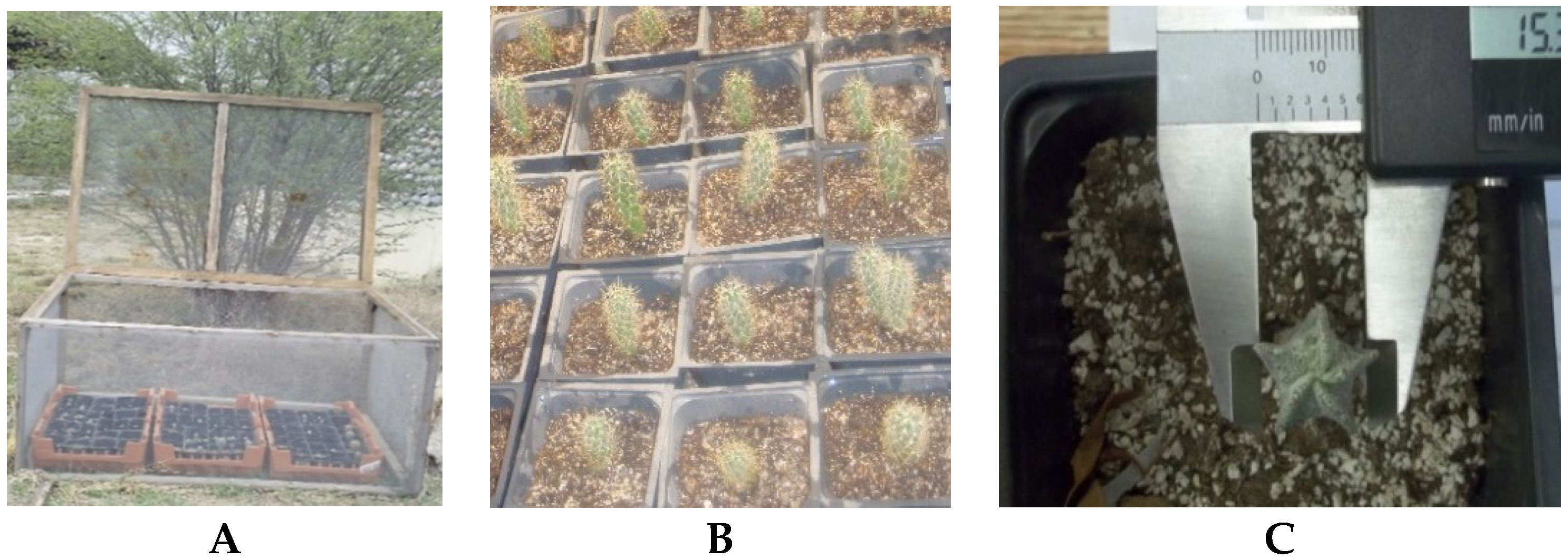
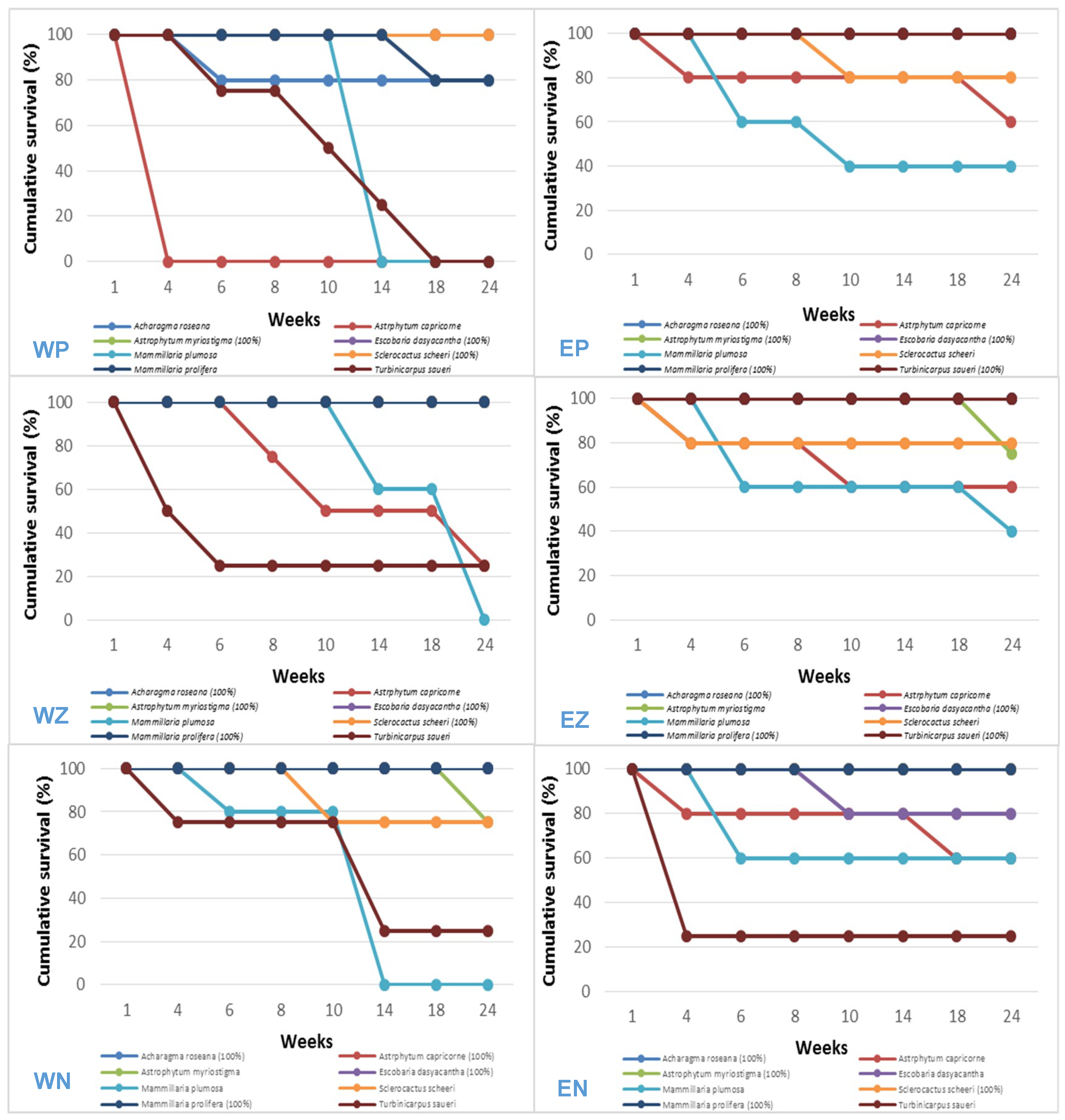
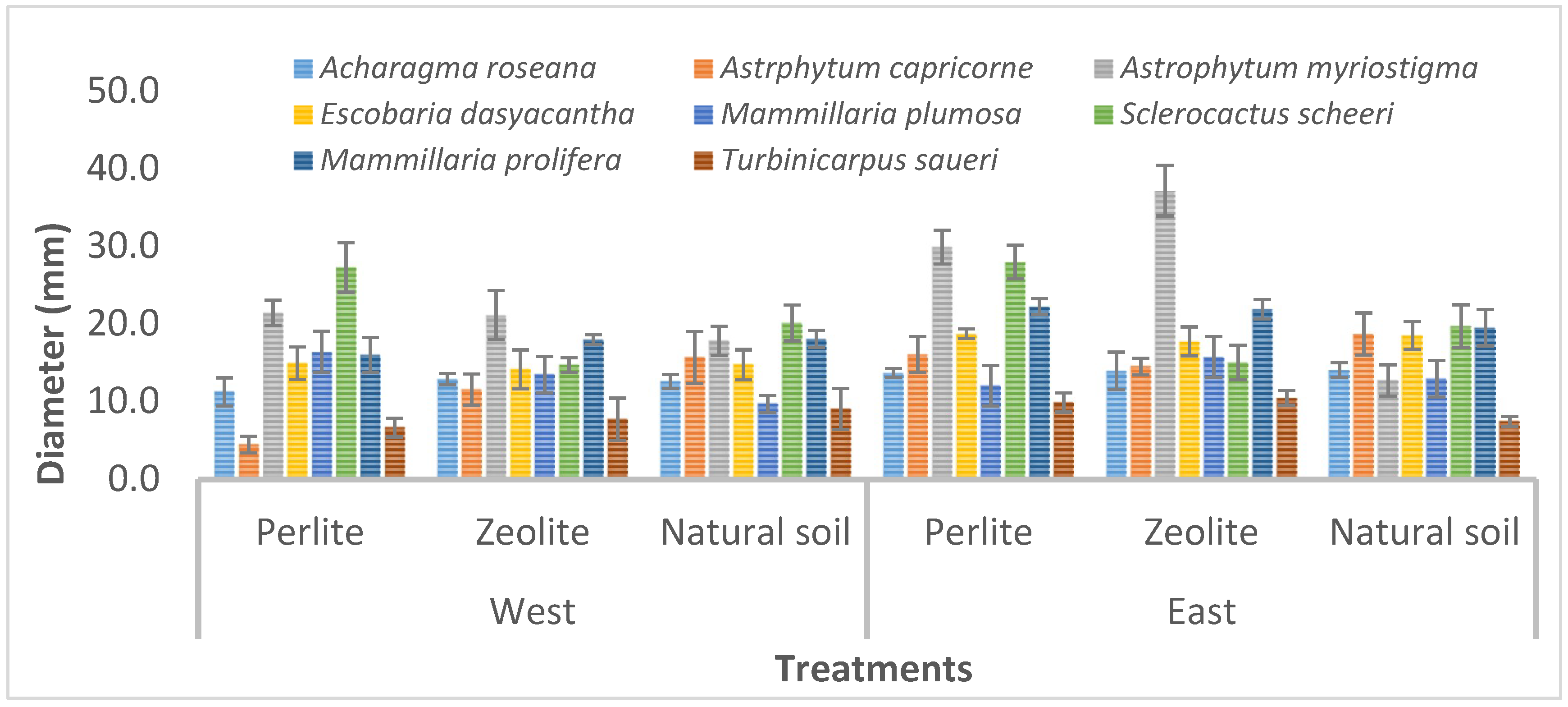
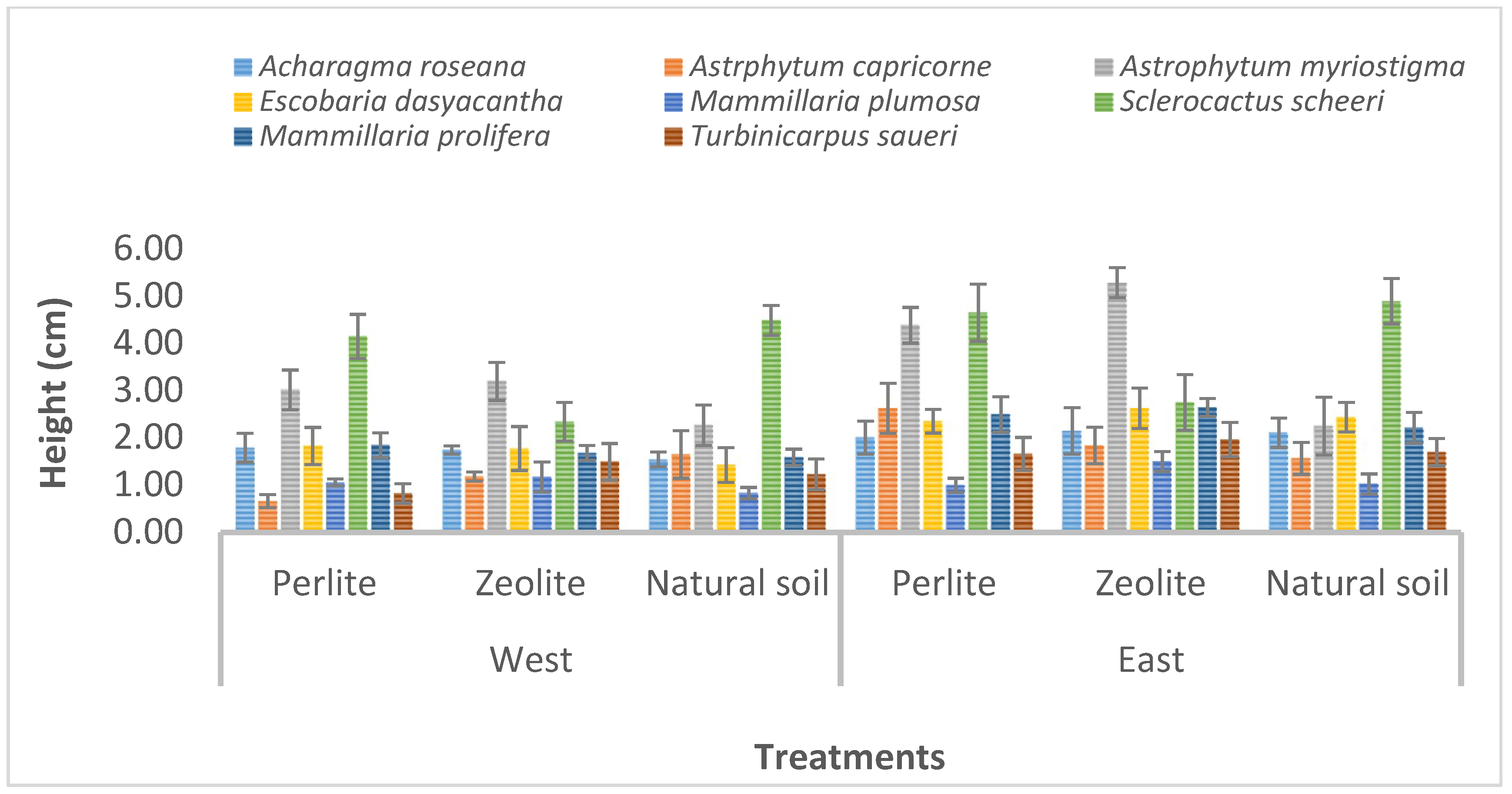
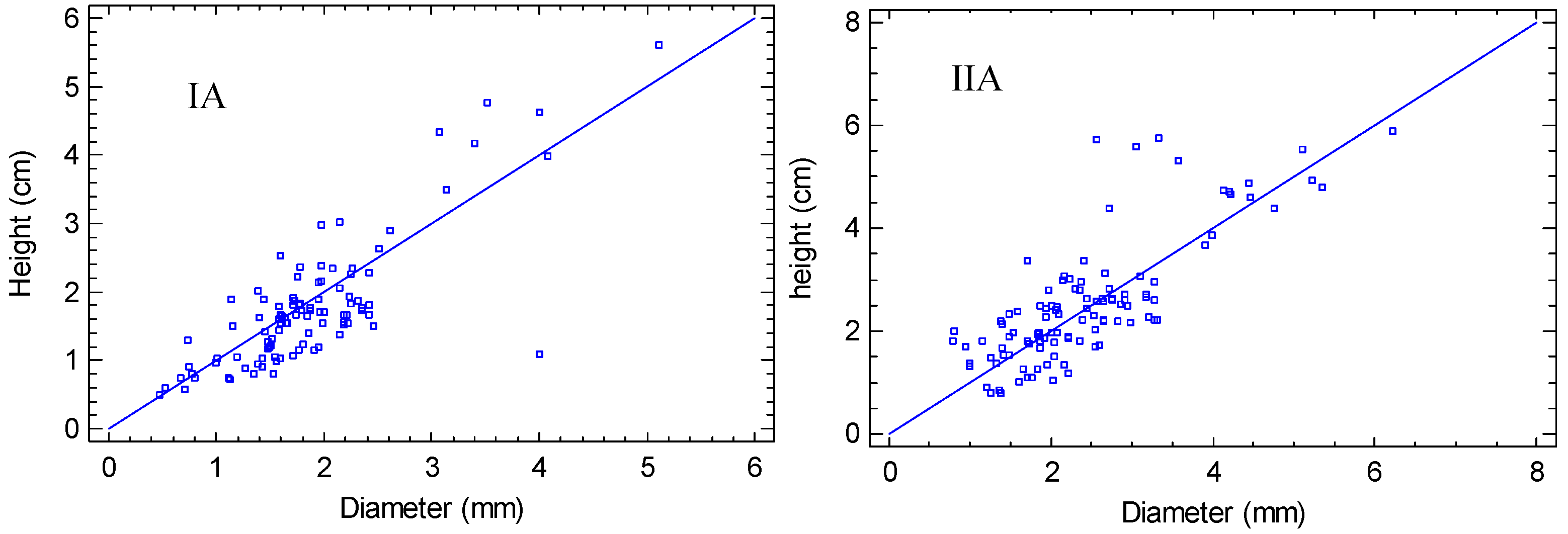

| Scientific Name | Ecological Protection Status | ||
|---|---|---|---|
| IUCN | CITES | NOM-059 | |
| Astrophytum myriostigma | LC | II | A, E |
| Acharagma roseana ssp. roseana | VU | II | Pr, E |
| Astrophytum capricorne | LC | II | A, E |
| Escobaria dasyacantha | LC | II | Not included |
| Mammillaria plumosa | NT | II | A, E |
| Mammillaria prolifera | LC | II | Not included |
| Sclerocactus scheeri | LC | II | Not included |
| Turbinicarpus saueri ssp. septentrionalis | VU | I | Not included |
| Variables | Diameter (mm) | Height (cm) | ||
|---|---|---|---|---|
| Fcal | p | Fcal | p | |
| Species | 17.666 ** | 0.000 | 24.956 ** | 0.000 |
| Sun exposure | 5.278 * | 0.023 | 15.932 ** | 0.000 |
| Substrate | 3.842 * | 0.023 | 2.970 NS | 0.054 |
| Treatments | Models | R-Square | p-Value | |
|---|---|---|---|---|
| West exposure | Perlite | Height = 0.481797 + 0.124304*Diameter | 69,4527 | 0.0000 |
| Zeolite | Height = 0.0797965 + 0.121432*Diameter | 64,2605 | 0.0000 | |
| Natural soil | Height = 0.0354579 + 0.0969969*Diameter | 63,4885 | 0.0000 | |
| East exposure | Perlite | Height = −0.271841 + 0.154658*Diameter | 73,6733 | 0.0000 |
| Zeolite | Height = 0.16758 + 0.131757*Diameter | 80,0724 | 0.0000 | |
| Natural soil | Height = −0.275067 + 0.174865*Diameter | 38,1618 | 0.0000 | |
© 2018 by the authors. Licensee MDPI, Basel, Switzerland. This article is an open access article distributed under the terms and conditions of the Creative Commons Attribution (CC BY) license (http://creativecommons.org/licenses/by/4.0/).
Share and Cite
Lidia Rosaura, S.C.; Rahim, F.P.; Lourdes, D.J.; Maginot, N.H. Growth and Survival of Endemic Cacti under Different Substrate Types and Sun Exposures for Their Optimal Establishment in Northeastern Mexico. Diversity 2018, 10, 121. https://doi.org/10.3390/d10040121
Lidia Rosaura SC, Rahim FP, Lourdes DJ, Maginot NH. Growth and Survival of Endemic Cacti under Different Substrate Types and Sun Exposures for Their Optimal Establishment in Northeastern Mexico. Diversity. 2018; 10(4):121. https://doi.org/10.3390/d10040121
Chicago/Turabian StyleLidia Rosaura, Salas Cruz, Foroughbakhch Pournabav Rahim, Díaz Jiménez Lourdes, and Ngangyo Heya Maginot. 2018. "Growth and Survival of Endemic Cacti under Different Substrate Types and Sun Exposures for Their Optimal Establishment in Northeastern Mexico" Diversity 10, no. 4: 121. https://doi.org/10.3390/d10040121
APA StyleLidia Rosaura, S. C., Rahim, F. P., Lourdes, D. J., & Maginot, N. H. (2018). Growth and Survival of Endemic Cacti under Different Substrate Types and Sun Exposures for Their Optimal Establishment in Northeastern Mexico. Diversity, 10(4), 121. https://doi.org/10.3390/d10040121






